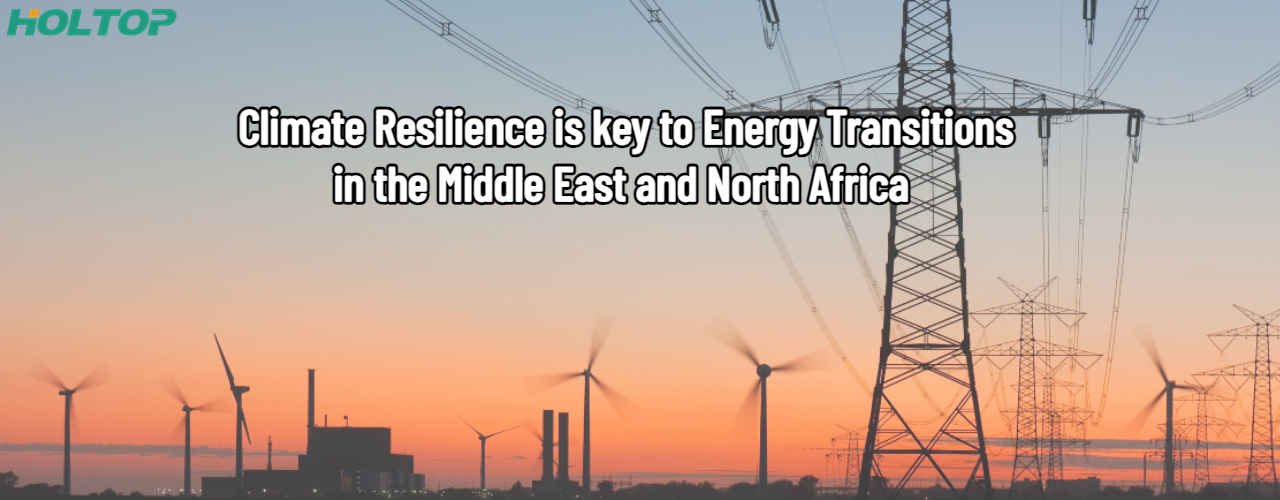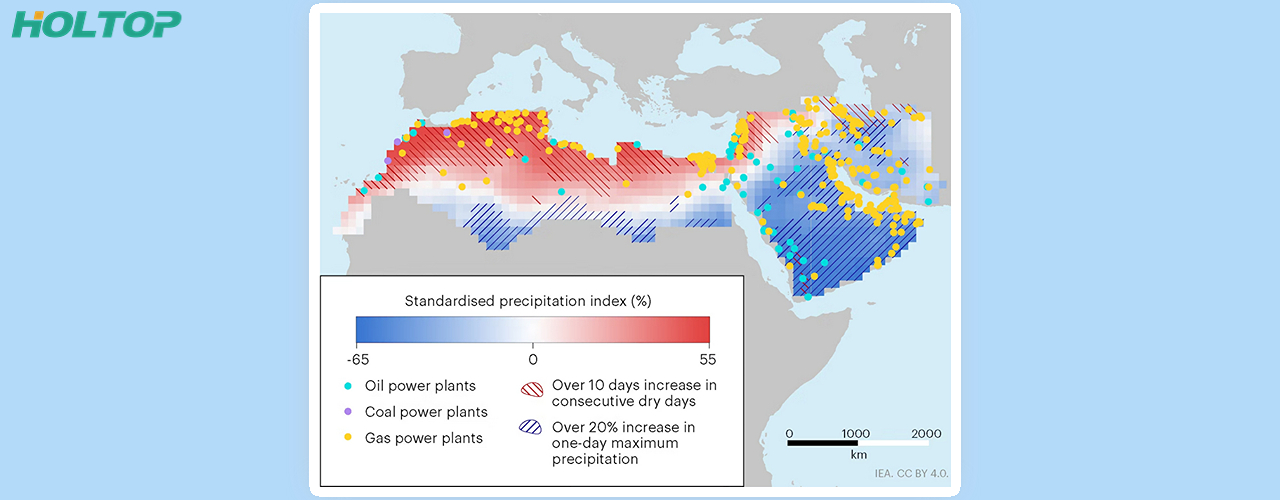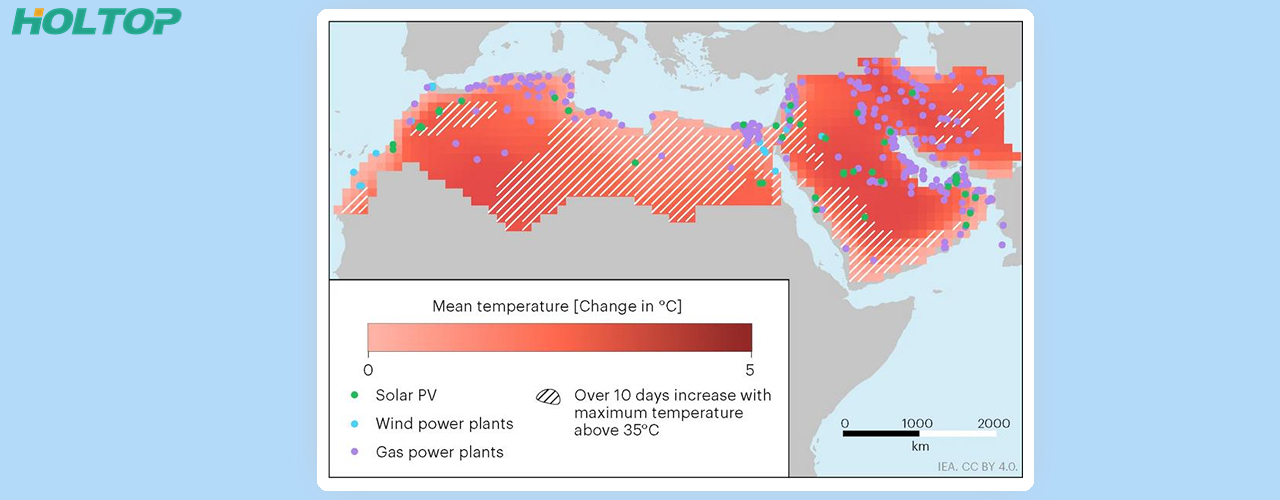
Climate change poses challenges to energy systems in the Middle East and North Africa
The Middle East and North Africa (MENA) is one of the world’s regions most affected by climate change, imposing challenges on energy systems that are already straining to meet the demands of economic growth, energy security and social welfare.
Between 1980 and 2022, temperatures across MENA increased 0.46°C per decade, well above the world average of 0.18°C1. Precipitation patterns have also changed significantly, aggravating existing water scarcity in some MENA countries, with droughts in Morocco in 2022 and Tunisia in 2023, while causing intense floods in 2022 in the United Arab Emirates, Iran, Saudi Arabia, Qatar, Oman and Yemen.
These climate events impact people, the economy and also energy systems. In Morocco, for example, higher temperatures have boosted electricity demand for cooling, straining a power system that is already stretched. To withstand rising peak demand, Morocco’s electricity imports from Spain in May 2022 reached record-high levels.
Even as they expand renewables generation to meet rising electricity demand and emission reduction goals, the region’s energy systems will also have to build in more climate resilience to cope with expected increases in climate impacts. With that goal in mind, the International Energy Agency has worked with regional partners (Egypt, Morocco and Oman) to conduct its first climate hazard and exposure assessment for MENA, based on the latest climate models and Graphic Information System (GIS) analyses.
Diversifying the energy mix with more renewables is a long-term answer to decreasing precipitation and increasing droughts
Decreasing rainfall and increasing incidents of drought are major concerns for the energy sector in some MENA countries, particularly in the southern and eastern Mediterranean region. Total precipitation in the southern and eastern Mediterranean region has decreased by around 8.3% per decade in the period 1980-2022. Annual mean precipitation is projected to further decrease in these countries while increasing in the Arabian Peninsula.
Declining water availability resulting from decreasing precipitation in southern and eastern Mediterranean countries is projected to negatively impact fossil-fuelled thermal power plants, which account for 91% of their electricity generation and rely on freshwater for cooling.
In all climate scenarios, more than 90% of fossil-fuelled thermal power plants in the southern and eastern Mediterranean region are projected to see a drier climate in the coming decade, although the level of aridity may differ among plants and among scenarios. If global greenhouse gas emissions (GHGs) are not mitigated, and fossil-fuelled thermal power plants in the region continue to operate, around 32% of coal power plants, 15% of gas power plants and 9% of oil power plants may face a “significantly” drier climate, which would have even greater impacts on cooling water availability. These rates are higher than the world average and neighbouring countries in the Arabian Peninsula which would experience a slightly wetter climate.

Precipitation changes in the Middle East and North Africa under the SSP2-4.5 scenario, 2081-2100
Notes: SSP2-4.5 is an emission scenario considered in the IPCC’s Sixth Assessment Report (AR6), in line with the upper end of aggregated NDC emissions levels by 2030 and associated with a global warming estimate for 2100 of around 3°C. The Standardized Precipitation Index compares cumulated precipitation on a period of interest (6 months in this case) with the long-term precipitation distribution for the same location and period. It is a scientific indicator used for the IPCC AR6 for detecting and characterising meteorological droughts. Around one third of fossil-fuelled power plants of the Middle East and North Africa region are located in the southern and eastern Mediterranean region, while the rest are in Arabian Peninsula. Only power plants with an installed capacity above 100 MW are shown on the map.
Some Mediterranean countries have already made efforts to reduce cooling water requirements and seek alternative water sources. Morocco is gradually replacing its coal-fired power plants with natural gas combined-cycle power plants which require less cooling water. Egypt adopted more water-efficient options for cooling new gas-fired plants (e.g., an air-cooling system for the 4.8 GW New Capital power plant) and reduced its dependency on freshwater by using seawater for the 4.8 GW El Burullus power plant.
Although these options could reduce water stress in the short term, the only lasting solution is a transition to clean energy in the region as well as across the world. If global GHGs from fossil-fuelled thermal power plants are not mitigated, climate change will continue to drive water scarcity and consequently pose further challenges to regional power plants.

Some renewable energy technologies such as solar PV and wind turbines are more resilient to drier climates because they require little or no water for operation. Moreover, their reduced GHGs could contribute to creating a virtuous circle, mitigating climate change and consequently curtailing shifts in precipitation patterns. Some southern and eastern Mediterranean countries have established ambitious targets for scaling up solar and wind power capacity, supporting global efforts to reduce GHGs. For instance, Morocco aims to expand the share of solar power in power generation from 1% in 2020 to 20% by 2030, and wind from 12.2% to 20%. These increases are expected to enhance power system resilience by offsetting projected decreases in hydro and coal-fired power capacity caused by increasing water scarcity.
Rising temperatures and extreme heat events raise additional concerns for energy system resilience in the region. Compared with the pre-industrial period (1850-1900), temperatures in 2081-2100 in MENA could rise 2.5°C in a low-emissions scenario and around 6.4°C in a high-emissions scenario, in both cases above global averages. More frequent extreme heat events pose a double challenge by increasing energy demand for cooling while cutting the efficiency of power plants.
In the past four decades (1980-2022), the number of cooling degree-days (CDD)3 increased by 0.6% per year in the MENA region. This trend is likely to continue, pushing average annual CDD up by over 30 under a low-emissions scenario and by around 1400 under a high-emissions scenario in 2081-2100 compared to the pre-industrial period (1850-1900). These higher projected summer temperatures are likely to trigger a notable increase in peak electricity demand during summer with more extensive use of air conditioning. In Oman, peak electricity demand increased from 6 060 MW in 2015 to 7 081 MW in 2021 with an average annual growth rate of about 3%, largely attributed to greater air conditioning use. Peak electricity demand in Oman is projected to continue to rise by around 4% per year until 2027.
As higher temperatures raise peak electricity demand, they also curtail the efficiency of power generation and networks, adding further stress to electricity supply. The performance of natural gas-fired power plants, which account for the largest share of electricity generation (74%) in the region, can be negatively affected by warmer air mass flow entering the gas turbine compressor. According to the IEA’s assessment, more than 80% of the installed capacity of gas-fired power plants in the region face an annual addition of more than 20 hot days (when maximum temperatures go above 35°C) in 2081-2100 in a low-emissions scenario, and over 60 days in a high-emissions scenario, which are both significantly higher than the world average. In the Arabian Peninsula, the level of exposure could go even higher, reaching around 90% of installed gas-fired capacity.
Key clean energy technologies can also be negatively affected by increased frequency and intensity of extreme heat events. Solar PV and wind power generation are generally designed for conditions around 25°C and become less efficient during heatwaves. Rising temperatures also make power lines heat up, expand or sag, reducing transmission capacity and leading to higher losses. According to the IEA’s assessment, most of the installed solar PV capacity in the region would see an annual increase of more than 20 hot days in a low-emissions scenario, and over 40 days in a high-emissions scenario. Similarly, 90% of wind power plants could be exposed to an increase of 40 hot days annually under a high-emissions scenario, although the level of exposure could drop significantly in a low-emissions scenario (45% of installed capacity exposed to an increase of more than 20 days).
To withstand the expected increase in extreme heat events, energy suppliers need to adopt more resilient designs for wind power plants and innovative cooling technologies for solar PV. Governments and consumers also need to seek energy efficiency improvements in cooling devices to manage increased electricity peak demand.
A climate-resilient energy transition presents solutions for three major overlapping goals: clean energy, energy security and climate change adaptation. Climate-resilient technologies are aligned with the region’s plans for emissions reductions, which drive further deployment of solar PV and wind. This diversification of energy sources contributes to energy security by enhancing readiness and robustness against climate-driven disruptions. In addition, it allows greater use of adaptation measures to withstand extreme weather events, such as air conditioning and healthcare services during heatwaves.
To support ongoing and future efforts towards climate-resilient energy transitions in the region, the IEA will release a series of country reports on Climate Resilience for Energy Transitions in Egypt, Morocco and Oman. These reports provide tailored assessments of various climate hazards to the energy systems in these three countries and discuss how to further improve existing policy measures. To share the key findings with a broader public, the IEA will hold a hybrid event in July, in collaboration with the governments of Egypt, Morocco and Oman.
Post time: Jul-15-2023








